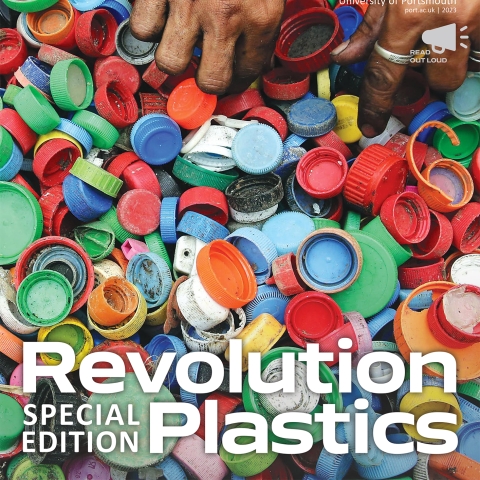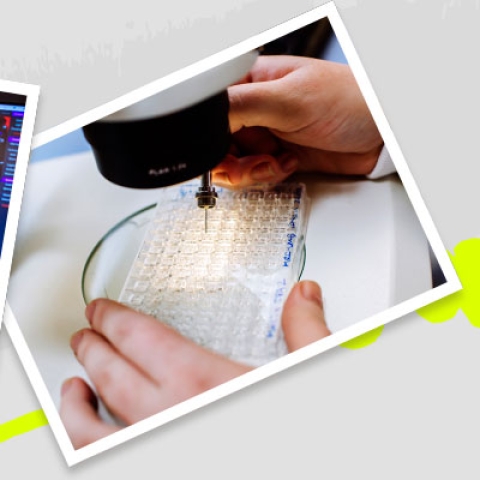

How many tiny plastic fibres are inside our homes and what is their impact on our health?
Dr Fay Couceiro is researching the extent of microplastics in the environment and how we can minimise their effects
Dr Fay Couceiro, Reader in Biogeochemistry and Environmental Pollution in the School of Civil Engineering and Surveying, explains what microplastics are present in our homes, where they come from and what we can do to minimise their impact on our health.
A lot of research has taken place examining the occurrence and impact of microplastics in the external environment, such as plastics in the oceans and litter in the natural environment.
Dr Fay Couceiro’s latest research brings the subject closer to home. Inside our homes, in fact.
What are microplastic fibres?
As plastics break down or shed from man-made materials, they break down into smaller and smaller pieces, known as microplastics.
Microplastics are defined as any plastic below 5mm in size. Some are even smaller and invisible to the naked eye. Airborne microplastics, for example, are 1/70th of the width of the average human hair and we can inadvertently breathe them into our lungs.
There is very little data available about microplastics indoors so, as part of Revolution Plastics, we’re measuring microplastics in different indoor environments – looking at the type, size and shape of the plastics found.
While more research is needed, studies have already shown that the concentration of microplastics indoors can regularly be 60 times higher than outdoors.
Plastics in our clothes and the air we breathe
Plastic is used everywhere, even in our clothes, bedding and furniture. Clothes often contain a blend of synthetic plastic-based fibres such as polyester, nylon or polyamide, which can shed we’re wearing and laundering garments.
In an investigation with Good Morning Britain (GMB), available to watch here, we examined the amount of microfibres in the air inside a typical family home.
Using specially designed air pumps we took samples from three rooms — the kitchen, master bedroom and children’s bedrooms — and measured the very small, breathable microplastics (less than 10 micrometres in size) from the indoor air.
The highest amount of microplastics found were in the children’s bedroom due to the carpets, non-cotton bed linen and soft toys. The measurement indicated that the family are likely each breathing in between 2,000–7,000 microplastics per day.
-
60 times higher
The concentration of microplastics indoors can regularly be 60 times higher than outdoors, studies have shown
-
2,000–7,000 per day
The number of microplastics that the family are likely each breathing in, according to our investigation with Good Morning Britain
-
20 million
The equivalent of 20 million pairs of socks may be washed down the drain as microfibres when we launder our clothes
Is it dangerous to breathe in microplastics?
Professor Anoop Jivan Chauhan MBE, Respiratory Specialist and Director of Research and Innovation at Portsmouth Hospitals University NHS Trust, was shocked by the results. The levels of microplastics in the air in this study are 100 times higher than any other academic research has previously predicted.
Aside from the environmental damage caused by plastics, there is growing concern about what inhaling and ingesting microplastics is doing to our bodies. We intend to conduct further research at the University of Portsmouth to discover more about how microplastics enter the human body and what their impact might be on our health.
For example, we’re working with Portsmouth Hospitals University NHS Trust to investigate the presence of microplastics in the lungs of chronic obstructive pulmonary disease (COPD) and asthma patients. The research may alert patients of risks or triggers for their condition, such as recently carpeted or hoovered rooms that may have a high number of fibres in the air.
We’re working with Portsmouth Hospitals University NHS Trust to investigate the presence of microplastics in the lungs of chronic obstructive pulmonary disease (COPD) and asthma patients. The research may alert patients of risks or triggers for their condition, such as recently carpeted or hoovered rooms that may have a high number of fibres in the air.
It all comes out in the wash
In a follow up study with GMB, available to watch here, we investigated what happens when we wash synthetic clothes.
We collected the wastewater from a washing machine so we could see how many fibres would have otherwise travelled into the sewer. This resulted in a visible pile of fibres. If every household in the UK did two washes like this a week, it would add up to the equivalent of over 20 million pairs of socks being washed down our drains every year.
There’s an implication for human health too. 90% of the microplastics in sewage end up in the sludge, which is used as fertiliser on agricultural land and can therefore end up in the food chain.
Plastic filters for washing machines
The issue of microplastic fibres being shed from our clothes during washing was raised in a bill in UK Parliament in 2021.
Alberto Costa MP is pushing for the UK government to follow in the footsteps of France, which has legislated for all new washing machines to have microplastic fibre filters fitted by 2025. The filters capture such fibres and prevent them from entering water streams.
How to reduce the number of microplastics in our homes
There are simple steps we can take to minimise the number of microplastics inside our homes.
- When replacing items in your home, such as furniture, carpets and toys, look for natural materials that don’t contain plastic.
- Fibrous materials such as faux fur tend to shed non-natural fibres into the air we breathe. Choose fabrics made with natural fibres instead, such as wool and cotton.
- Try to keep plastic items out of direct sunlight as this causes materials to break down and release airborne microplastics.
How can microplastics be detected?
Some microfibres, like those in the washing wastewater, could be detected with the naked eye, but what about tiny microplastics?
To identify these in the University lab, we use a special microscope called a micro-Raman, which can reveal tiny pieces of plastic below 1 micrometre in size and determine their polymer type.
This enhances our research as we’re able to identify microplastics in the air and potentially those with the ability to enter the bloodstream. Only a handful of UK universities have this specialist equipment.
More recently we purchased a one-of-a-kind mega laser, which can rapidly analyse the chemical composition of plastics, metals and even dust. The femtosecond laser ablation (LA) and laser induced breakdown spectroscopy (LIBS) system – installed at the University of Portsmouth in 2021 – is the only one of its kind at any university in the UK or Europe. Among other uses, it will help us to understand how microplastics may harm human health.
This takes place within our Microplastics Research Group, which takes a holistic, interdisciplinary look at microplastics. We’re studying their impact in all environments — including soil, air, water — and their impacts on plant, animal and human health. Most importantly our research is focussed on identifying solutions to limit the impact of microplastics.
Explore related research and stories
SOLVE Magazine
Our SOLVE magazine covers the extraordinary work carried out by our research teams that stand to make a difference in the world

Life Solved
A podcast lifting the lid on the latest ideas and discoveries set to change our lives.

Research and innovation
Find out more about research opportunities at Portsmouth, and how you can help us tackle the planet's most urgent challenges. Start your research journey today.

